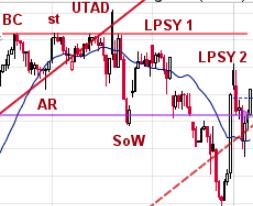Wyckoff Method in Action: Intriguing Insights into the Intraday Timeframe
Understanding market dynamics, especially in the intraday timeframe, requires a keen eye for detail and a comprehensive trading strategy. One such strategy that has gained popularity among traders is the Wyckoff Method. Developed by Richard Wyckoff, this method focuses on analyzing the relationship between price action, volume, and time to identify potential trends and trading opportunities. In this article, we delve into the application of the Wyckoff Method in the intraday timeframe, exploring key concepts and practical insights that can help traders navigate the fast-paced world of day trading effectively.
Accumulation and Distribution Phases
Central to the Wyckoff Method are the concepts of accumulation and distribution phases. During accumulation, smart money (institutional investors and large market players) accumulates shares at lower prices before driving up the price during the markup phase. Conversely, during distribution, smart money sells off their shares to less informed traders before the downtrend kicks in.
Identifying these phases in the intraday timeframe requires a deep understanding of price and volume action. Traders can look for signs of accumulation, such as price consolidating near support levels on increasing volume, followed by a breakout to the upside. On the other hand, distribution phases may be characterized by price churning near resistance levels with decreasing volume, signaling a potential reversal.
Market Structural Analysis
Another key aspect of the Wyckoff Method is market structural analysis, which involves studying the overall market structure to identify potential trends and reversals. This analysis includes tracking the development of higher highs and higher lows in an uptrend, and lower highs and lower lows in a downtrend.
In the intraday timeframe, traders can apply market structural analysis to gauge the strength of the current trend and anticipate potential reversals. By identifying key support and resistance levels and monitoring price action around these levels, traders can make informed decisions on entry and exit points.
Volume Analysis
Volume analysis plays a crucial role in the Wyckoff Method, providing insights into the strength of price movements and potential trend reversals. In the intraday timeframe, sudden spikes in volume can indicate the presence of institutional activity or significant news events driving market sentiment.
By analyzing volume in conjunction with price action, traders can confirm the validity of price movements and identify potential entry and exit points. Volume surges on breakouts or breakdowns can signal the beginning of a new trend, while low volume during consolidation phases may indicate a lack of interest from market participants.
Practical Applications and Trading Strategies
Applying the Wyckoff Method in the intraday timeframe requires a holistic approach that considers the interplay between price action, volume, and time. Traders can use this method to identify potential accumulation and distribution phases, analyze market structure, and leverage volume analysis to make informed trading decisions.
One practical trading strategy based on the Wyckoff Method is the Spring and Upthrust pattern. A spring occurs when price briefly dips below a support level before quickly rebounding, signaling a potential buying opportunity. Conversely, an upthrust happens when price briefly breaks above a resistance level before reversing lower, offering a selling opportunity.
In conclusion, the Wyckoff Method provides traders with a comprehensive framework for analyzing market dynamics in the intraday timeframe. By incorporating concepts such as accumulation and distribution phases, market structural analysis, and volume analysis, traders can enhance their decision-making process and improve their overall trading performance in the fast-paced world of day trading.

